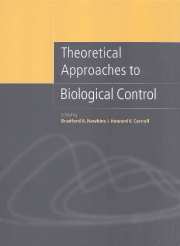Part V - Microbes and pathogens
Published online by Cambridge University Press: 13 August 2009
Summary
In the past, biological control mostly depended on the use of arthropods as control agents, and the long history of applied ecological theory reflects this emphasis. The use of pathogens has been much more restricted, with myxoma virus for rabbit control representing one of the few exceptions. Consequently, the theoretical development of host–pathogen interactions has only occurred within the past 20 years. This imbalance is likely to shift in the next century for at least two reasons, (i) pathogens are typically highly specific, which should reduce their impact on non-target organisms, and (ii) pathogen genomes are easier to engineer than those of predators or parasitoids, so the attributes that facilitate control can more easily be manipulated. Further, the scope of biological control is being expanded, and pathogens also are beginning to be targeted. This section begins with an overview of the development of host–pathogen theory by Godfray & Briggs (Chapter 17). Despite differences in the biologies of pathogens and other types of natural enemies, many of the processes that are being explored in predator–prey and host–parasitoid theory also characterize pathogens. For example, Godfray & Briggs discuss the importance of host refuges, host density dependence, spatial heterogeneity, multiple-species interactions, and equilibrium versus non-equilibrium dynamics. These have been addressed in other sections of this book, but here the focus is on biological control using pathogens as agents.
- Type
- Chapter
- Information
- Theoretical Approaches to Biological Control , pp. 305 - 306Publisher: Cambridge University PressPrint publication year: 1999



